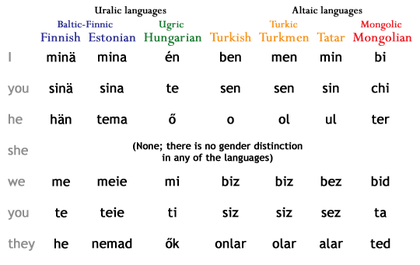1

















| Thumbs Up/Down |
| Received: 2,833/1,047 Given: 1,720/1,162 |














| Thumbs Up/Down |
| Received: 1,096/184 Given: 1,505/100 |



















| Thumbs Up/Down |
| Received: 5,404/770 Given: 6,855/520 |













| Thumbs Up/Down |
| Received: 2,833/1,047 Given: 1,720/1,162 |



















| Thumbs Up/Down |
| Received: 5,404/770 Given: 6,855/520 |


You mentioned some good aspects, and I can only agree with your subjective impression, but other people like me have this impression the other way around. I have left this subjective way of observing for a long time, I am more concentrated in a objective (Nostratic or Borean) way which in many cases explains similarities between distantly related languages.
1. Did you ever asked yourself why two 1st person pronouns exist for the same meaning: I & me? In Turkic we have öz and min/men/bin/ben. Kurdish has ez and min. German has ich and mein. Japanese has wáǸ, bànù, ánù. The pronouns me and we in most world languages have the same linguistic base root *mV ('I, we'). In Turkic the number "one" reads as bir, but it is also used with the meaning "mono, single, someone, person". Also compare Proto-Germanic '*wīz' ("we") and Proto-Turkic '*biz' ("we"). The root, doesn't matter if plural or singular, is always *ba, *be, *bi, *ma, *me, *mi etc. in all proto-forms around the globe.
Indo-European and its closest relatives. 1. Grammar. Joseph Harold Greenberg Stanford University Press, 2000.
2. The negation suffix in Turkish has two forms: -ma and -me. In other Turkic languages like Kazakh it is -may and -mey. Japanese has a similar nagation suffix: -nai (archaic -mai). Compare tabemai ('not eat').
3. Also compare Turkic verbal suffix -mek/-mak and Germanic make/mach-. For more see: http://www.theapricity.com/forum/sho...tic-allegories



















| Thumbs Up/Down |
| Received: 5,404/770 Given: 6,855/520 |


The common 1st person pronoun among Uralics and Altaics btw:




















| Thumbs Up/Down |
| Received: 5,404/770 Given: 6,855/520 |


Ouh, and Petros, common sense in comparative linguistics is still that there is no need for typologically related languages to be also genetically related and vice versa. Proto-Indo-European including Nostratcic were agglutinative btw.



















| Thumbs Up/Down |
| Received: 5,404/770 Given: 6,855/520 |


Bump it!
The Scytho-Iranian hypothesis, taken literally, would predict some genetic continuity from the ancient Indo-Iranian Scythians to their modern Indo-Iranian descendents. But archeological and genetic studies performed up to date consistently fail this test[citation needed], and instead consistently point to Uralic-Altaic genetic make-up (Voevoda M.I. et al. "Reconstruction ..."), detested by Iranist proponents for its Mongoloid/Lapponoid component unbecoming for pure "Arian" Indo-Europeans.
















| Thumbs Up/Down |
| Received: 6,154/1,071 Given: 10,212/98 |


Not again ...
You know this is going to cause a huge flame war now ...



















| Thumbs Up/Down |
| Received: 5,404/770 Given: 6,855/520 |
There are currently 2 users browsing this thread. (0 members and 2 guests)
Bookmarks